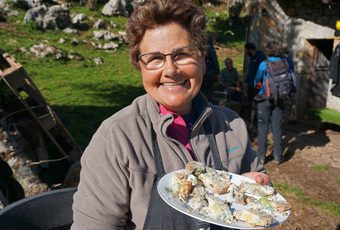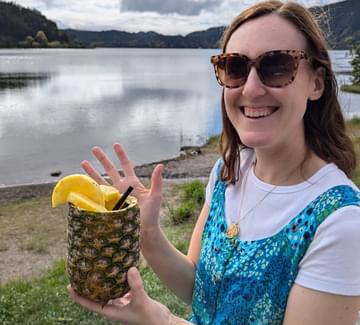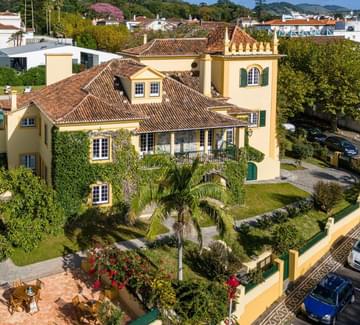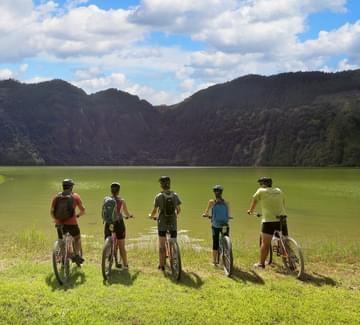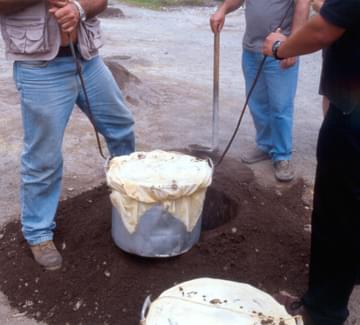Azores Holidays
Our holidays take you far beyond just 'seeing' the sights, inviting you to experience the Azores at their most vibrant, quirky and tasty. These are journeys of memorable food, unique wine, local characters and larger-than-life stories. Of crater lakes, whales and hot springs. Of epic sunsets and starry skies. Of the very best of the Azores, shared in our inimitable Pura way.
7 Trips
-

![b&b in caloura on sao miguel island]()
![host team at cabins in sao jorge]()
![sete cidades landscape hydrangeas]()
![coffee beans and man sao jorge azores]()
![horta murals pico volcano azores]()
![woman in hot springs in the azores]()
![limpetes in the azores]()
![wine tasting on pico island]()
![floating in natural pool in the azores]()
![lady with pineapple by lake on sao miguel]()
Azores Island Hopping: Whales, Wine & Volcanic Wonders
- Four islands
- Stunning views
- Packed with Azorean culture
From£2,800pp -

![boutique hotel in ponta delgada]()
![swimming pool above atlantic in pico]()
![learning to surf in the azores]()
![cycling at sete cidades]()
![whale watching azores]()
![walking in forests on sao miguel]()
![hot springs pool at terra nostra gardens]()
![monte verde beach azores]()
![hydrangeas at sete cidades viewpoint]()
![team at lava homes villas on pico]()
![cozido emerging from underground in furnas]()
Azores Island Hopping Family Adventure
- Laugh-out-loud fun
- Beach chill time
- Fantastic places to stay
From£2,850pp -

![lady looking at pico volcano in criacao velha]()
![terra nosta gardens furnas]()
![b&b caloura sao miguel]()
![azores wine company hotel]()
![cow on rounabout in pico highlands]()
![azores whale watching]()
![sunset over vila franca do campo islet]()
![WINE TASTING PICO AZORES]()
![hot springs terra nostra gardens]()
![tasting menu dinner pico]()
![lady at sailor paintings in horta marina]()
Azores Discovery Escape
- Crater lake views
- Memorable hotels
- Azores highlights tour
From£2,000pp -

![lisbon lady serving pastel de nata]()
![sete cidades landscape view]()
![azores wine hotel from above]()
![whale watching azores]()
![woman looking over tagus river in lisbon]()
![thermal baths terra nostra gardens furnas]()
![wine tasting on pico island in the azores]()
![staff at cabins hotel on sao jorge island]()
![coffee beans drying in sun in the azores]()
![tea harvesting on sao miguel]()
![lady watching sunset in lisbon]()
Azores Island Hopping with Lisbon
- Lisbon like a local
- Epic natural beauty
- Whales, walking & wine
From£3,550pp -

![casa portuguesa hotel ponta delgada]()
![kayaking at sete cidades]()
![children surfing in the the azores]()
![canyoning on sao miguel island]()
![whale watching sao miguel azores]()
![terra nostra hot springs furnas]()
![monte verde beach azores]()
![girl smiling next ot fern in furnas, sao miguel]()
![girl walking in village on sao miguel island]()
![family cycling at sete cidades]()
Azores Family Adventure Escape
- Epic nature
- Awesome activities
- A week on São Miguel island
From£1,700pp -

![sete cidades viewpoint]()
![hotel in ponta delgada]()
![dolphins in sea at sao miguel island]()
![WALKING in terra nostra gardens in furnas]()
![tasting menu dinner sao miguel]()
![hiking to lagua do fogo]()
![cooking cozido in furnas]()
![hot springs sao miguel caldeira velha]()
![strolling through tea plantations in sao miguel]()
![lady with pineapples at furnas lake]()
Azores Winter Escape: Crater Lakes & Hot Springs
- Hot spring heaven
- Great hiking
- Slow travel in quiet season
From£1,350pp
Loading more holidays...
Frequently Asked Questions
What makes Pura Aventura's trips different?
When is the best time to visit the Azores?
What will the weather be like?
How active are these trips?
Is the Azores a good hiking destination?
How can I reach the Azores?
How do I get around?
What is it like to drive on the Azores?
Can I combine the Azores with mainland Portugal?
Azores with Pura Aventura

Natural Wonders
Seeing the sights is one thing, truly experiencing them is quite another. Cycle in a volcano crater, hike through native cloud forest, soak in lava hot springs and snorkel with tropical fish.

Local Flavour
We want to immerse you in the culture of the Azores. You can meet winemakers, coffee growers and tea harvesters, chat to artisans in their workshops and have a BBQ with local families.

Special Hotels
The places you stay are always memorable. From a cabin nestled in tall trees to a boutique wine hotel below a volcano and B&Bs by the sea, expect peace, great views and the warmest welcomes.





